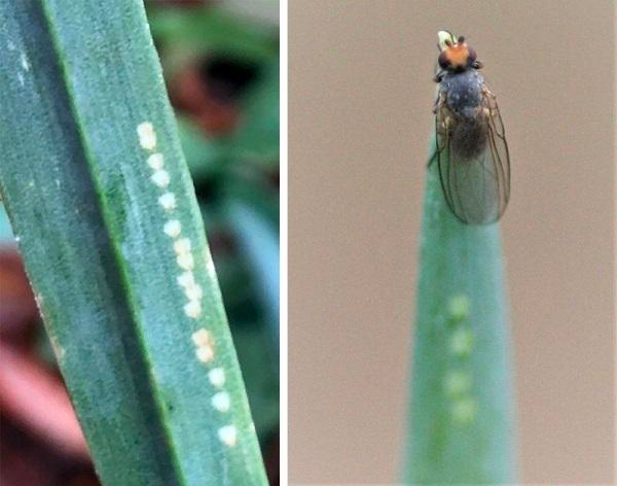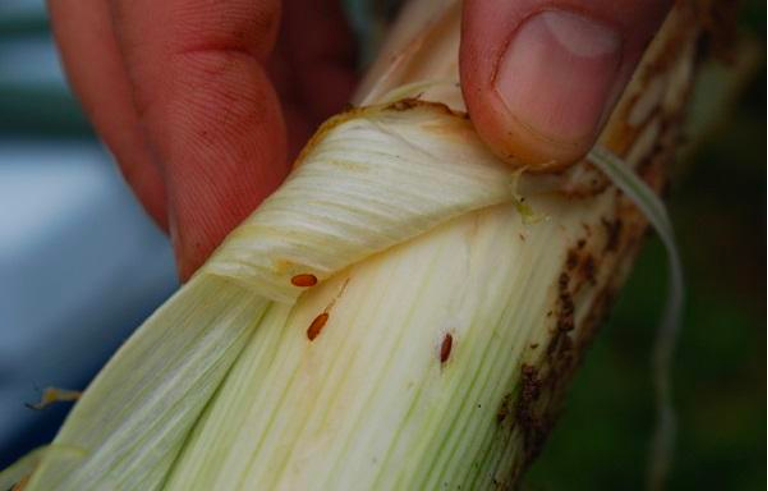
Pest: Allium Leafminer (Phytomyza gymnostoma)
Pest/disease identification and lifecycle, most common damage symptoms and crops affected:
Allium, or onion, leafminer (ALM) is an invasive pest of alliums.
Adult allium leafminers are small (approximately 3 millimeters) gray/black flies with a distinctive orange/yellow spot on the tops of their heads, and yellow “knees” (Fig. 1). ALM have two generations in a year. Adults that overwintered in the soil from the previous year begin to emerge in late winter through early spring (March through May) and lay eggs into plant stems. That first generation of eggs then hatches as larvae which mine the leaves, moving downward towards the bulb or base of leaves. They then pupate in plant tissue or in the soil through the summer (Fig. 2), until they emerge as adults in the early autumn, and quickly begin to lay a second generation of eggs into the leaves of various alliums, whose larvae will once again mine the leaves of these plants. It’s this second generation of ALM that is often most damaging to crops. The second generation of pupae will then overwinter in the soil.

Fig. 1. Left: Puncture damage from ALM. Right: ALM adult with distinctive orange head. Courtesy of B. Lingbeek, Penn State Extension
Allium leafminer can infest any species in the genus Allium, including onion, garlic, shallot, green onion, and ornamental and wild alliums. Leeks are often the most damaged, likely because the second generation has the greatest population potential to damage crops and most other allium crops have been harvested by the time the larvae are hatching.
While damage is typically worst in fall crops like leeks from the second generation of this pest, overwintered onions, perennial chives and early scallions may provide ideal scouting sites to catch the arrival of this new invasive pest if it has spread to you. Overwintered adult allium leafminer flies emerge when growing degree day (base 1 C) accumulation reaches 350. Around that time, adult allium leafminers will emerge, mate and begin ovipositing — the most obvious sign of their presence. To calculate the growing degree days (base 1 C) in your area, as well as the expected accumulation in the coming six days, locate the nearest weather station data to you that participates in the NEWA monitoring network, and then select the DD Calculator from the Weather Tools. Growing degree days are calculated starting at the beginning of the calendar year (January 1) and you may need to input today’s date as the “end date” of the calculation. Also, be sure that the calculator is set to a base temperature of 1 C. Maine has entered into agreement with the NEWA network, but unfortunately is currently deficient in weather stations that are connected and reporting to it.

Fig. 2. ALM pupae under leaf sheaths near the base of the plant. Courtesy of Lawrence Barringer, Pennsylvania Department of Agriculture
The first sign of damage from ALM is typically the appearance of repeated punctures in leaf tissue (Fig. 1). Adult females make these punctures with their ovipositors to lay eggs within leaf sheaths, and both female and male adults feed on the plant exudates from these wounds. Once hatched, larvae mine leaves moving towards the plants’ bulbs and roots. Punctures and mines create opportunities for bacterial and fungal pathogens to enter plants. In heavily infested fields, up to 20-100 pupae can be found in individual plants, with 100% of plants infested.
Management options:
Cultural:
To monitor for ALM, scout for telltale repeated punctures in allium leaves in September-October. Adults have also been found on yellow sticky cards.
To exclude ALM from plantings, cover allium plants in early spring, during the first adult emergence. Covering fall plantings to exclude the second generation of ALM may also be effective.
Biocontrol options:
There are no known effective biocontrols at this time.
Pesticides approved for use in certified organic production (as a last resort):
Azadirachtin (e.g., Aza-Direct for farmers) and spinosad (e.g., Entrust for farmers or Captain Jack’s Deadbug Brew for gardeners) products can be effective. Follow label instructions for leafminers.
Organic growers can use Entrust (6 ounces per acre) plus M-Pede (1-1.5% volume/volume solution), applied two times, two to four weeks after detection.
Please note: This information is for educational purposes. Any reference to commercial products, trade or brand names is for information only, and no endorsement or approval is intended. Pesticide registration status, approval for use in organic production and other aspects of labeling may change after the date of this writing. It is always best practice to check on a pesticide’s registration status with your state’s board of pesticide control, and for certified organic commercial producers to update their certification specialist if they are planning to use a material that is not already listed on their organic system plan. The use of any pesticide material, even those approved for use in organic production, carries risk — be sure to read and follow all label instructions. The label is the law. Pesticides labeled for home garden use are often not allowed for use in commercial production unless stated as such on the label.
Sources
Written by Mariam B. Taleb and Caleb Goossen.
Modified from University of Maryland Extension Resources, written by Gerald Brust September 2021, and “Major Pests of Onion,” University of Massachusetts Extension, May 2021.
